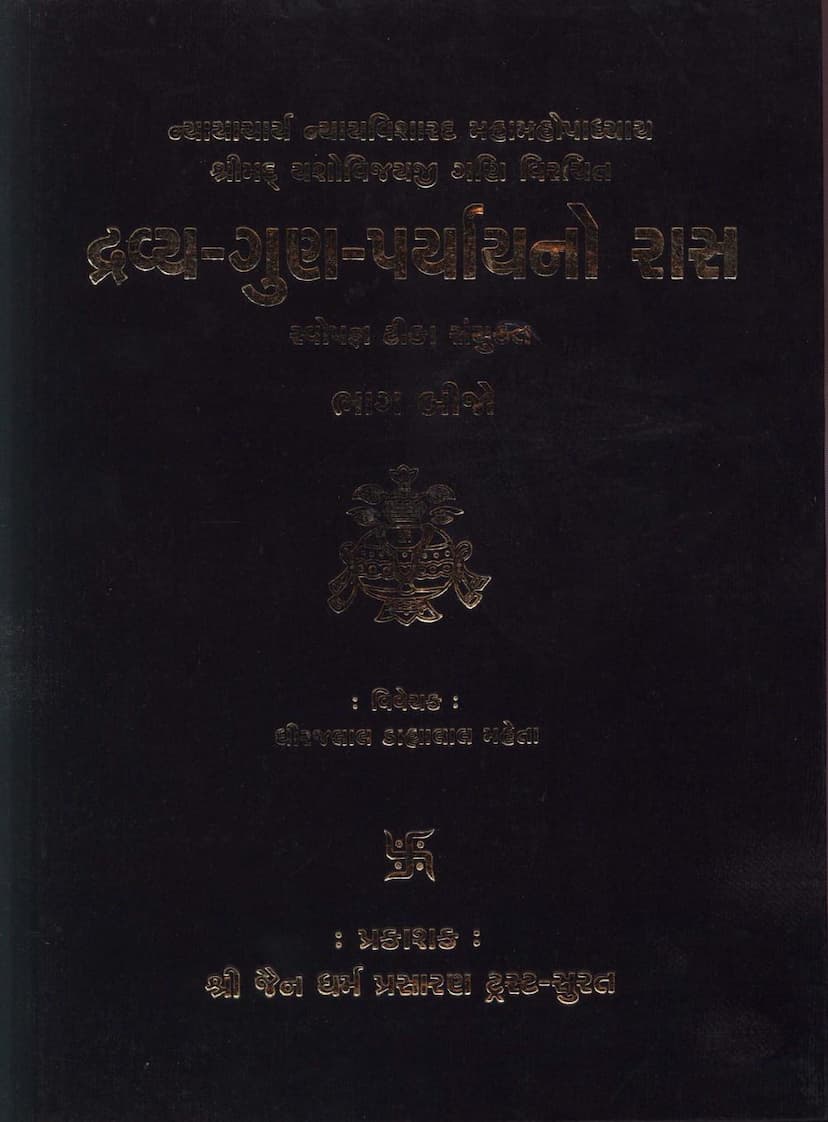Dravya Gun Paryaya No Ras Part 2
Added to library: September 1, 2025

Summary
This document is a comprehensive summary and analysis of the Jain text "Dravya Gun Paryaya no Ras Part 2" by Yashovijay Upadhyay and Dhirajlal D Mehta, published by Jain Dharm Prasaran Trust, Surat. The provided text is the introduction and exposition of the book. Here's a breakdown of the key aspects:
1. Book Details:
- Title: Dravya Gun Paryaya no Ras Part 2 (The Essence of Substance, Qualities, and Modes in Jainism, Volume 2)
- Author: Yashovijay Upadhyay (Original text), Dhirajlal D Mehta (Commentator/Editor)
- Publisher: Shri Jain Dharm Prasaran Trust, Surat
- Year of Publication: Vikram Samvat 2061 (AD 2005)
- Catalog Link: https://jainqq.org/explore/001097/1
2. Content and Context: The document provides an extensive introduction to the life and works of the original author, Upadhyay Yashovijayji Maharaj, a prominent Jain scholar and saint. It then delves into the "Dravya-Gun-Paryaya no Ras" itself, explaining its significance within Jain philosophy.
3. Key Themes and Sections:
- Author's Lineage and Life: The document meticulously details the guru-shishya lineage leading to Yashovijayji Upadhyay, tracing it back to Acharya Hirvijaysurishwarji Maharaj. It recounts Yashovijayji's birth, upbringing, renunciation, monastic initiation, rigorous study of Sanskrit and Prakrit scriptures, mastery of various philosophical schools (darshanas), his intellectual prowess demonstrated through Avadhan (mnemonic feats), his debates, and his ultimate attainment of the title "Upadhyay."
- The Text "Dravya-Gun-Paryaya no Ras":
- Significance: It is considered a foundational text in Jain philosophy, particularly in the Dravyanuyog (the study of substances and their inherent reality). The text aims to explain the complex concepts of Dravya (Substance), Guna (Qualities), and Paryaya (Modes/States) in a poetic and accessible Gujarati format (Ras).
- Content: The book explores the six substances (Dravyas) of Jainism, their general and specific qualities (Guna), and their ever-changing modes (Paryaya). It highlights the philosophical concept of Kathanachit Bhed (somewhat different) and Kathanachit Abhed (somewhat identical) concerning substances, qualities, and modes, which forms the basis of Saptabhangi (the theory of sevenfold judgment).
- Philosophical Depth: It discusses the anuyogas (categories of discourse) and emphasizes the primary importance of Dravyanuyog for spiritual progress. The text also offers a critique of Digambara interpretations, particularly from texts like Pravachansar and Nayachakra, highlighting perceived deviations from core Jain principles.
- Structure: The "Ras" is structured into 17 dhals (sections), with a total of 285 gathas (verses). The document provides a detailed summary of the key themes covered in each dhal, from the invocation and introduction of anuyogas to the explanation of dravya, guna, paryaya, nayas (standpoints), saptabhangi, and finally the nature of dharma, adharma, akasha, kala, jiva, and pudgala substances. It also touches upon the author's own spiritual journey and the inspiration behind his extensive literary contributions.
- Yashovijayji's Literary Contributions: The document lists over 80 known works by Yashovijayji Upadhyay, categorizing them into original works, commentaries on earlier texts, and poetic/simplified versions of complex philosophical topics in Gujarati. This highlights his prolific writing and his dedication to spreading Jain knowledge in various formats.
- Commentary by Dhirajlal D Mehta: The current publication is a commentary (vivechan) by Dhirajlal D Mehta, which aims to simplify and clarify the complex philosophical concepts within the "Ras" for the benefit of a wider audience. The document mentions the inspiration and effort behind this commentary and expresses gratitude to various individuals and institutions for their support.
- Endorsements and Blessings: The latter part of the document includes several aashirvad vachano (words of blessing) and abhiprayo (opinions) from respected Jain scholars and saints, praising Yashovijayji's work and the commentary by Dhirajlal Mehta. These endorsements highlight the profound spiritual and intellectual value of the text and the commentary.
3. Philosophical Concepts Discussed:
- Dravya (Substance): The fundamental reality that underlies all changes. The text discusses the six eternal substances in Jainism.
- Guna (Qualities): The inherent and inseparable attributes of a substance.
- Paryaya (Modes/States): The transient, changing states or manifestations of a substance.
- Naya (Standpoints): The different perspectives through which reality can be viewed, crucial for understanding the anekantavada (non-absolutism) of Jainism.
- Saptabhangi: The theory of sevenfold judgment, arising from the interplay of naya and the real nature of substances, which states that a thing can be described from multiple, seemingly contradictory, viewpoints.
- Unity and Multiplicity: The text grapples with the paradox of how a single substance can have multiple qualities and modes, and how the same entity can be both permanent (in its substance) and transient (in its modes).
- Critique of Other Philosophies: The text, particularly in its critique of Digambara views and other philosophical schools, aims to establish the correctness and comprehensiveness of the Jain perspective, especially concerning dravya-guna-paryaya and the correct understanding of nayas.
4. Significance: The "Dravya-Gun-Paryaya no Ras" is highly regarded for its attempt to explain profound Jain metaphysics in a poetic and accessible manner. Yashovijayji's ability to synthesize complex philosophical ideas into verses is a testament to his scholarship. The commentary by Dhirajlal Mehta further enhances its value by making it more understandable to contemporary readers. The text is seen as a guide to understanding the nature of reality, the soul's journey, and the path to liberation through right knowledge, perception, and conduct.
In essence, the document serves as a detailed preface and overview of a significant Jain philosophical work, highlighting the life of its author, the book's content, its philosophical underpinnings, and the positive reception it has received from the Jain scholarly community.